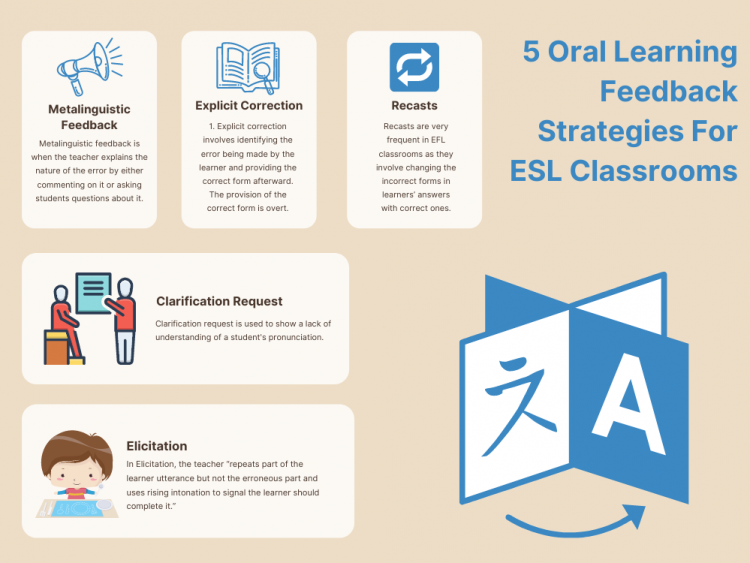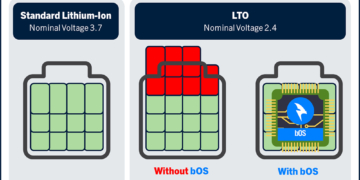contributed by Aziz Ghannaj
It goes without saying that feedback is an essential concept in language teaching as it “has a place in most theories of second language (L2) learning and language pedagogy” (Ellis, 2009).
It should be used to enhance learning within an ESL classroom. Interestingly, oral feedback is the most frequent type of feedback in language classrooms as it is prominently introduced by teachers. In this article, I will define oral feedback and state its different types as well as mention some of its strategies.
Terms
What is EFL? EFL is the teaching of English as a foreign language for a non-native English speaker
What is ESL? ESL is similar to EFL but refers specifically to English being taught as a second language (whereas EFL doesn’t necessitate that English is necessarily a ‘second’ language–an in fact, both terms are often used interchangeably).
Oral feedback or verbal feedback plays a vital role in language teaching and learning. It is part and parcel of the interaction between teachers and learners in every learning environment. It can be defined as “information given to learners which they can use to revise their interlanguage” (Ellis, 1999). To wit, EFL learners often resort to their L1 to grasp a rule or comprehend certain linguistic items; and in doing so they make mistakes in the target language.
See also 20 Effective Learning Feedback Strategies
So, this is where oral feedback comes in to provide immediate and instant guidance to students throughout their learning process. Moreover, Khairani and Refnaldi believe that “Oral feedback is the teachers’ response to the students’ performance in the teaching and learning process” (2020) and this response usually clarifies misconceptions for learners and it will ultimately move them on in their learning. All in all, oral feedback is regarded as the essence of the interaction between teachers and students.
Oral feedback can be evaluative, corrective, descriptive, or motivational. To begin with, Evaluative feedback involves a value judgment of learners’ performance or work. This judgment can take the form of grades or brief general comments during class time. Furthermore, while creating a typology for assessment, Tunstall and Gipps (1996) classified evaluative feedback into rewarding, punishing, approving, and disapproving. Evaluative feedback, however, doesn’t provide learners with detailed and specific information to improve their learning. Corrective feedback, as the name presupposes, usually “takes the form of response to a learner utterance containing a linguistic error” (Ellis, 2009).
Accordingly, a teacher has to correct learners’ errors which signal a problem in competence; not mistakes that might be due to learners’ poor performance. For Ellis, the response to a learner’s error should first indicate the error, second provide the correct target language form and third explain the nature of the error. As far as descriptive feedback is concerned, it is “the specific information about students’ strength and weakness and improvement strategies” (Hargreaves, McCallum & Gipps (2000)). In other words, this type of feedback describes learner’s current achievement and compares it to expected results so as to help learners understand what they need to improve.
Lastly, motivational feedback is as important as the above-mentioned types of feedback since it is used to give students a charge to function well. According to Mackiewicz & Thompson (2013), “motivational feedback aims to encourage students in learning”. This encouragement can take the form of praise, expressions of sympathy, or empathy.
There are many strategies that teachers resort to, either consciously or unconsciously, to give oral feedback. In a study published in 1997, Lyster. R and L. Ranta distinguished five frequent strategies used by teachers to correct students’ errors.
1. Explicit correction involves identifying the error being made by the learner and providing the correct form afterward. The provision of the correct form is overt.
Student: “I study English in Monday”
Teacher: “We say ON Monday”
2. Recasts are very frequent in EFL classrooms as they involve changing the incorrect forms in learners’ answers with correct ones. The reformulation of students’ utterances is, however, implicit as recommended by the Communicative Language Teaching Approach. An example of recasts would be:
Student: “He speak English”
Teacher: “ yeah right, he speaks English”
3. Clarification request is used to show a lack of understanding of a student’s pronunciation. It can also be used to indicate that what students said is incorrect and that they are required to repeat it again correctly.
Student: “We are study now”
Teacher: “ Excuse me. ”
Student: “ We are studying now”
4. Metalinguistic feedback is when the teacher explains the nature of the error by either commenting on it or asking students questions about it. The teacher shouldn’t supply the learners with the correct form but let them discover it by themselves.
Student: “we goed to the cinema yesterday”
Teacher: “there is a mistake here…..is the verb ‘go’ regular or irregular? ”
Student: “ irregular”
Teacher: So, what should we say?
Student: We went to the cinema yesterday.
5. Elicitation is the last oral feedback strategy we will be discussing in this article. It refers to the ways teachers use to draw learners’ attention to the incorrect part of their utterance. In so doing, the teacher “repeats part of the learner utterance but not the erroneous part and uses rising intonation to signal the learner should complete it” (Ellis, 2009).
Student: “The apple is eating by the boy”
Teacher: “The apple is……………… ”
Student: “The apple is eaten by the boy”
Note that all the examples provided above are inspired by my classroom practices.
By and large, teachers need to be aware of the above-mentioned oral feedback strategies so that they can effectively help students improve and bridge the gap between the current performance and the desired one.
In conclusion, no one can deny that oral feedback is vital to the learning-teaching process. Teachers around the world believe that without constructive and timely feedback, students might be lost in the task at hand which can prevent them from achieving their learning goals. I personally believe that we still have a long way to go when it comes to investigating ‘feedback’ in EFL classrooms.
Teachers are invited to reflect upon their practices and figure out which oral feedback strategies they resort to most and which ones less. This, hence, can have strong impact on both learning and teaching and can make a teacher’s responses to students’ utterances concise, precise and objective-oriented.
References:
Ellis, R. 2009. Corrective Feedback and Teacher Development. L2 Journal, 1 (1), 3-18. Gipps, C., McCallum, B., & Hargreaves, E. (2000).
What makes a good primary school teacher? Expert classroom strategies. London: Routledge Falmer.Khairani,I & Refnaldi, R. (2020).
English Teachers’ Oral Feedback In Teaching And Learning Process Journal of English Language Teaching Volume 9 No. 1. Lyster, R., & L. Ranta. (1997). Corrective feedback and learner uptake: Negotiation of form in communicative classrooms. Studies in Second Language Acquisition, 19, 37-66.
Mackiewicz, J. & Thompson, I. 2013. Motivational Scaffolding, Politeness, and Writing Center Tutoring. The Writing Center Journal, 33 (1), 38-73.
Tunstall, P., & Gipps, C. (1996). Teacher feedback to young children in formative assessment: a typology. British Educational Research Journal, 22(4), 389–404.















